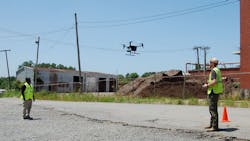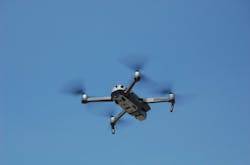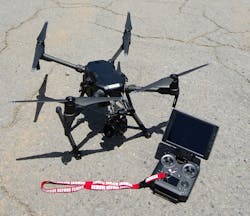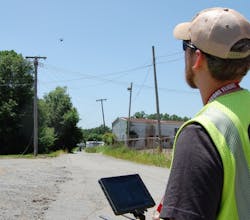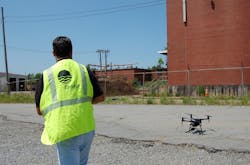Entergy Arkansas Drone Team Takes New Approach to R&R
Entergy Arkansas’ drone program has certainly not been taking it easy. The team of three employees and two high-tech drones has been flying hundreds of miles of power lines, inspecting equipment and finding ways to strengthen the electric grid. The team especially flies difficult lines and circuits to detect potential problems that could cause power outages.
With drones, scouting out power lines can be done much more efficiently – especially in hard to reach areas. The unpiloted aerial vehicles (UAVs) act as a force multiplier during times when resources can be stretched thinly.
How It All Started
Drones have been around Entergy Arkansas for a few years now, but the utility’s proactive program began about a year ago when Joseph Boyd, vegetation operations coordinator for the baseline network in Little Rock, became a certified Entergy drone operator and began doing drone inspections. His focus is primarily on trees, tree growth and potential vegetation issues on or near power lines that could cause an outage.
A few months after Boyd began his drone flights, he was joined by Aaron Scruggs, another Entergy-certified drone pilot who focuses on poles, wire, insulators, transformers and other components of the electric system. Recently, Anthony Johnson, an Entergy Arkansas engineer, joined the team and currently serves as a visual safety observer. A licensed drone operator, Johnson is working to become an Entergy-certified drone pilot, as well.
Entergy drone inspections help to spot problem areas at a low cost and can scout power lines within just a few minutes, whereas it can take hours or days for workers to visually inspect some power lines. Drone inspections reduce truck rolls, which also saves money. Instead of sending workers to scout the lines, the drone team can look at the drone photos and see whether anything needs addressed. If something does not look right on a piece of equipment, the footage can be distributed to others. Drone footage has been shared with numerous departments, including distribution, engineering, vegetation and even corporate communications.
Just like all-terrain vehicles (ATVs), bucket trucks and climbing gear have their uses, so, too, do drones. Drones do not need to be used in all situations, but for inaccessible lines and getting sophisticated data, they are worth their weight in gold.
More Than Inspection
Hurricane Ida is an example of Entergy Arkansas’ R&R drone team at work. Before the hurricane even hit the Gulf Coast in 2021, Boyd was called to south Louisiana to help look for access points for airboats to get into affected areas quickly once the hurricane passed.
Airboats can go about anywhere, but it was not always clear where they needed to be. By using drones, Entergy was able to show the best entry points for the airboats.
Once Hurricane Ida hit the area, Entergy drone pilot Boyd was called to Baton Rouge, Louisiana, U.S., to help assess damage. The drone was able to go in and see exactly what was broken in a good-sized neighborhood that had a lot of rear-lot lines.
When Boyd arrived, he asked the assessment teams on foot how long they had been there. They said they had been there about 1 hr and 10 min and had gotten two streets assessed. The drone went in there, flew the lines and captured every detail of every single street in about 15 minutes.
Earlier in 2022, the drones also were valuable in helping with Arkansas’ storm response. In the Forrest City area, swampy and flooded conditions made it difficult for crews to identify damage that was easily detectable and accessible by a drone.
A few months later, the drone team helped in the southeastern part of the state. A 25-mile (40-km) line that stretches from Gurdon to Okalona to Antoine through a river bottom was flown in three hours, whereas as it would have taken workers in an ATV three days to patrol it.
All these efforts helped to get the lights on quicker for customers and saved money in the process.
Before Takeoff
The most important day-to-day task, before the drones take off on any flight, is inspecting the drones. Before a recent flight, one of the Entergy pilots found out the drone’s camera was not sending video as smoothly as it normally does.
After a few days of inspection, the team discovered the drone’s cable was damaged. This would have been a horrible experience to be called out for a job, get everything set up and fly the lines, only to find out there was unusable footage or no footage. Daily drone inspections are critical.
Flying Restricted Areas
One of the unique qualities of Entergy’s drone operators is their knowledge of engineering, reliability and drones. Each individual brings a different skill set, which makes the team diverse. However, one of the biggest challenges is getting flight permits in restricted areas on or near big airports.
In early 2022, the team needed to scout a distribution line near the Hot Springs Airport, which has restricted airspace around it and requires advanced approval straight from Washington D.C. Permits, especially like the one needed to fly in the Hot Springs Airport confines, are not easy to acquire quickly. In this case, to expedite the process to perform emergency storm scouting in the mountains, Entergy’s unmanned aircraft systems (UAS) program manager was able to secure the permit from Washington within an hour or so.
More To Come
Currently, the R&R drone team is working to add new cameras that will provide advanced spectral, thermal and mapping technologies to enhance resiliency even further.
Spectral cameras will enable the crew to detect tree defects, decaying or dying plant species to identify and target them for removal. They also can detect core rot in poles that cannot be seen during visual inspection. Currently being tested at Entergy, the cameras are expected to save the utility money on its hazard tree program.
The thermal capability will enable the drones to detect changes in temperatures on power lines. What one cannot see with the naked eye, the thermal-equipped drones will see that a transformer or something else is hotter than everything else. Diagnosing can become much easier. The thermal capacity is effective for inspecting substations and transmission lines. For example, thermal imaging can detect whether a line splice, insulator or switch is about to fail, so the utility can make repairs before a problem occurs.
Another feature in the new equipment is light detection and ranging (LiDAR). It will enable the team to measure power lines for global positioning system (GPS) and 3-D mapping as well as confirm current mapping is correct. LiDAR also will help to predict the growth rates of plants and trees to help determine how often vegetation trimming is needed for the reliability of power lines.
The drone team will have the ability to get all the data they need — from geographic information system (GIS) and engineering data to vegetation and construction data — and the capability to broadcast anywhere, anytime. If the team finds an imminent issue, they can land the drone and send the photo from a phone to anyone who needs to see it.
Entergy’s drone team operates like Navy Seals, spearheading the utility’s mission with every ounce of energy they can. They focus on safe scouting, faster restoration times and documenting every issue while out in the field. The drone’s geotagging feature pinpoints the exact location a photo is taken, which means no guessing which tree is rotted or damaged and needs to be removed. Being safe and delivering reliable and resilient energy to customers is the drone team’s goal.
Aaron Scruggs is an Entergy engineer and an Entergy-certified drone pilot.
Joseph Boyd is a vegetation operations coordinator and an Entergy-certified drone operator.
Kacee Kirschvink ([email protected]) is manager of communications at Entergy Arkansas.
About the Author
Aaron Scruggs
Aaron Scruggs is an Entergy engineer and an Entergy-certified drone pilot.
Joseph Boyd
Joseph Boyd is a vegetation operations coordinator and an Entergy-certified drone operator.
Kacee Kirschvink
Kacee Kirschvink ([email protected]) is manager of communications at Entergy Arkansas.
